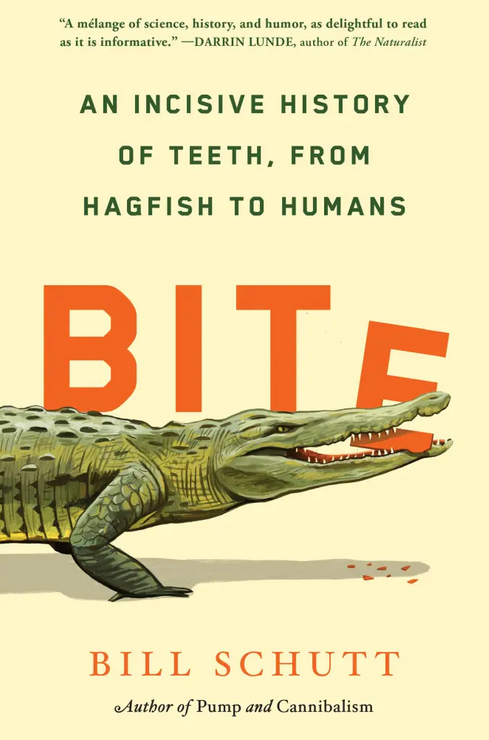Bite: An Incisive History of Teeth, from Hagfish to Humans
- By Bill Schutt
- Algonquin Books
- 320 pp.
- Reviewed by Gretchen Lida
- September 6, 2024
Those pearly whites do more than just shine.

I struggled to control myself while writing this review of zoologist Bill Schutt’s Bite. The desire to insert teeth jokes was as overwhelming as the book’s number of strange facts is staggering. I wanted to write sentences like, “He cut his teeth on other scientific topics in his earlier books Pump and Cannibalism” and “Did Schutt bite off more than he could chew by trying to cover everything from prehistoric sharks to George Washington?”
Yet after much consideration — nay, gnashing of teeth — I realized that while my humor isn’t nearly as smart or well researched as Schutt’s, it does match the lively tone and often giddy joy that make this new work of nonfiction sparkle. Whether it’s the fact that vampire bats don’t suck blood (they slurp) or that forensic dentistry was used as far back as the American Revolution, each detail is dropped with cheerful enthusiasm.
The chapter titles — including “Fangs a Lot,” “A Painless Guide to Tooth Basics,” and “A Man of Few Words…and Fewer Teeth” — are clever and colloquial, too. Even those of us who compulsively brush at the mere mention of a cavity will find the banter delightful.
While Bite is fun and the tone is perfectly approachable, however, it’s not plot-driven. The lack of a narrative arc is by far one of the biggest stumbling blocks of many popular-science books, and this one is no exception. Sure, gnarly information about lionfish venom is always welcome, but it may not be enough to inspire some readers to devour Bite cover to cover.
Having said that, losing the plot isn’t necessarily a bad thing. In fact, the book’s lack of connecting chapters might be its virtue. Imagine a dad at the beach reading about the nightmarish clime that is the inside of a hagfish’s mouth. He could pause to glance up and make sure the kids are all accounted for, then look back down and not worry that he’s lost the storyline. Later, in true dad fashion, he could spout off about how whale baleen, made of keratin, is more like hair than teeth. Then he could watch his children die of embarrassment over having such a nerd for a father.
Bite, might I add, would be perfect for dentists’ waiting rooms. Patients could peruse it before being called back, and later, when being manhandled by an overzealous hygienist, comfort themselves by remembering it’s modern times and we no longer attempt to transplant live teeth from one person to another. (Spoiler alert: It never worked.)
The pace slows in places, especially when Schutt is writing about obscure animals. (At times, I had to stop and ask, “Wait, which species of fish are we talking about again?”) But two things make Bite worth reading all the way through: its footnotes and its illustrations. Each section has a generous amount of both, and they’re often fascinating, terrifying, or funny. An image of ancient Etruscans’ golden dental bling gives the phrase “No cap” a deeper meaning. And a drawing of the tiny, hooked teeth that allow baby bats to cling to their mothers is as cute as it is creepy.
Bite is also the rare nature book with next to no moral thesis. With the exception of a reminder that sugar’s rise in popularity fueled the need for modern dentistry — and that it’s not a great idea to grab toothy venomous snakes — Schutt makes no clarion call for humans to change their behavior. This lack of a rallying cry is at once refreshing and possibly an explanation for why the chapters don’t quite gel.
Okay, I’ve been talking out of both sides of my mouth. As someone who pays an equine dentist to file her horse’s teeth every couple of years and who also works in a high-poverty school district, I come away from Bite with mixed feelings. On one hand, I love a good animal fact and always want more funding for the study of the natural world. On the other, I know that access to affordable dental care is no joke, and that people’s socioeconomic status can dramatically impact the condition of their teeth.
As I read, I kept thinking about Sarah Smarsh’s 2014 essay, “Poor Teeth,” which talks about the connection between poverty and dental health. Bite never denies this reality — and Schutt offers examples of how it has played out in the past — but the ramifications of having bad teeth (and the value of having good ones) aren’t really explored. I’m not sure what to do with this bit of dissonance, but it’s something to chew on.
Gretchen Lida is an essayist and an equestrian. Her work has appeared in the Washington Post, the Rumpus, the Los Angeles Review of Books, and many other publications. She is a contributing writer at Horse Network and the Independent, and host of “HN Reads,” a podcast about horse books. She lives in Chicago.

.png)